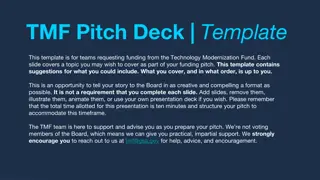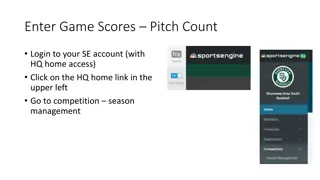Game Development Pitch Deck
This pitch deck is the culmination of thorough preparation and research, providing a detailed conclusion for a presentation. It includes important sections such as studio introduction, game motivation, elevator pitch, gameplay details, and unique selling points. The deck is polished with impressive visuals, solid data, and attention to detail. Useful resources for revenue estimations, Twitch statistics, and player sentiment are also included.
Uploaded on Sep 18, 2024 | 1 Views
Download Presentation

Please find below an Image/Link to download the presentation.
The content on the website is provided AS IS for your information and personal use only. It may not be sold, licensed, or shared on other websites without obtaining consent from the author.If you encounter any issues during the download, it is possible that the publisher has removed the file from their server.
You are allowed to download the files provided on this website for personal or commercial use, subject to the condition that they are used lawfully. All files are the property of their respective owners.
The content on the website is provided AS IS for your information and personal use only. It may not be sold, licensed, or shared on other websites without obtaining consent from the author.
E N D
Presentation Transcript
Tips & tricks (delete in final pitch deck) The content of this deck should be the conclusion of a ton of preparation and research from your side. The commission will expect that you can go into much more detail during the Q&A of the hearing. You can add slides if crucial information is missing or delete slides if not applicable. But please follow this template as closely as you can. Polish this deck with impressive art, strong copy, gifs, solid numbers, attention to detail works! In theory you should be able to pitch this deck in approx. 15 minutes. We will NOT ask you to pitch this deck during the hearing. At the hearing you can give a max. 5 slide update on the project.
Useful resources (delete in final pitch deck) Revenue estimations: gamalytic.com Twitch statistics: sullygnome.com Player sentiment: steamdata.ninja Pricing, active players and more: steamDB.info GameDiscoverCo newsletter by Simon Carless Levelling The Playing Field by Rami Ismail Game Developer Games Industry GameDaily
Studio(s)/Team(s) Briefly introduce the studio and your (core) team. What makes you different, what are the strengths of your team (specifically for this project)?
Why this game? Explain the motivation behind why you are making this specific game. In the best case scenario you have both artistic (creative vision) and business motivations (market opportunity).
Elevator pitch + specs Elevator pitch: be concise (3 lines max.) Specs: Platform(s): Genre: Number of players: Length: Target Price: Target Audience:
Gameplay trailer/Playable code Link to an online server with video material of the game, this can be raw footage, trailers, include gameplay footage, even if it is still rough. Link to playable code (it doesn t have to be fully stable yet). Don t forget to add passwords if you use them.
USPs Point out what makes your game stick out from similar games. Use images and/or gifs to illustrate.
Gameplay loop Describe the key mechanics of the game, use screenshots and/or gifs to illustrate.
Game progression Show how you will build on the core gameplay loop to keep things interesting throughout the entire game.
Game modes Describe the key modes of the game, use screenshots and/or gifs to illustrate.
Art Show how your game stands out visually through (if available) concept, character and environment art.
Main story beats (if applicable) What about your narrative will hook the player? Give an example.
Inclusion How do you aim to make your game: authentic (cf. principle 'nothing about us, without us') accessible identifiable for a broad audience (representation)
Engagement How will you keep players engaged? This is especially important for longer games and live service games.
Technological innovation (if applicable) Which new technology did you develop and how does it impact the game?
Comparative analysis Compare with similar games that have released recently. Use tools and do your research thoroughly, prove your game is viable. Don t be afraid to approach developers of similar games directly to get the most reliable info possible. In the next slide you can find a grid to visually represent this analysis. Please adapt the names of the axes (bright yellow) to your own game.
Comparative Grid Short Sessions Game B Game A Strategic Fast-Paced Game C Game E Game D Long Sessions
Traction Prove that others think your game is cool. Could be: Community / social media Steam wishlists Awards Press coverage Special partners, consultants, secured funding,
Production timeline Make a visual representation with all of the milestones for features.
Budget Give a rough budget overview (the detail will be in your separate financial plan).
Funding Which funding do you have in place or are you persuing at which point in production? Use a timeline.
Marketing strategy How will you approach the markting of the game? Is this based on previous learnings?
Partners Are you working with a publisher, PR agency, etc. Mention them here and the status of the relationship (letters of intent, contracts, ). Any deals with platform holders in place?
Performing targets Present your best, medium and worst case scenario sales wise, and outline what those mean for the future of the studio.
Outro End with a strong visual and your contact info.
Acknowledgements (delete in final pitch deck) We would like to express our sincere gratitude to everyone that inspired and/or helped us in creating this pitch deck. Special thanks to game studios Triangle Factory, LuGus Studios, Fishing Cactus and eXiin. And to freelance wisemen Richie de Wit and Rami Ismail.























